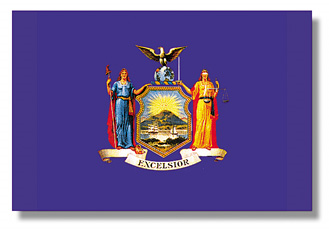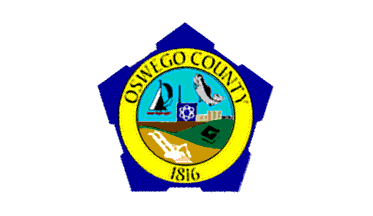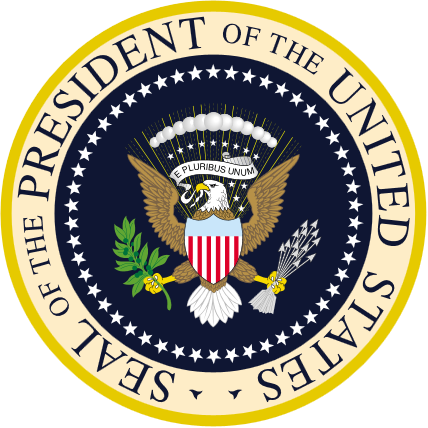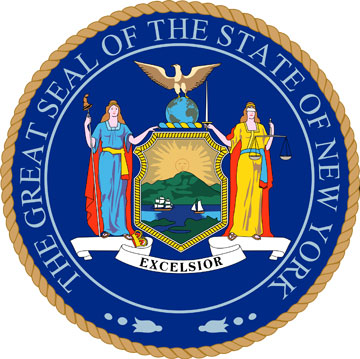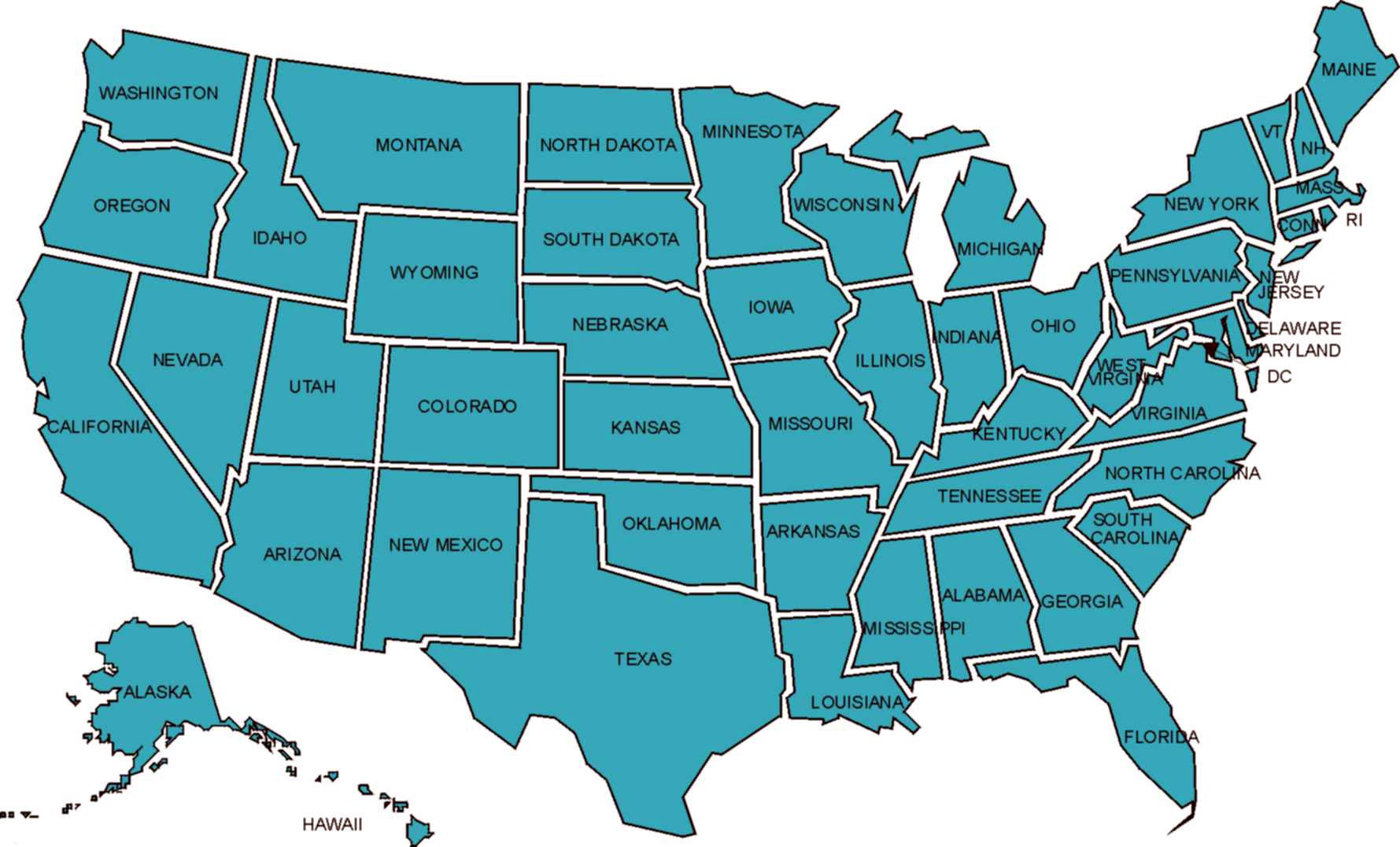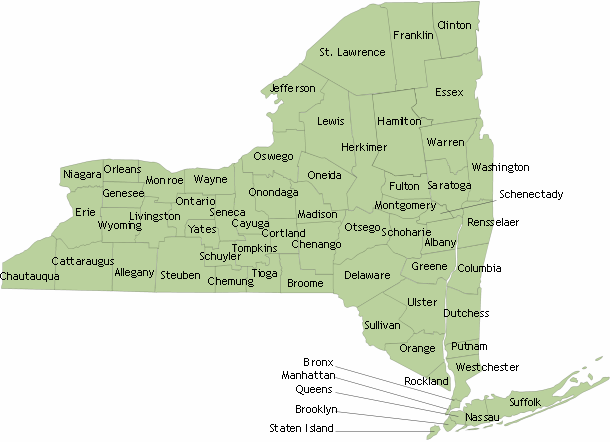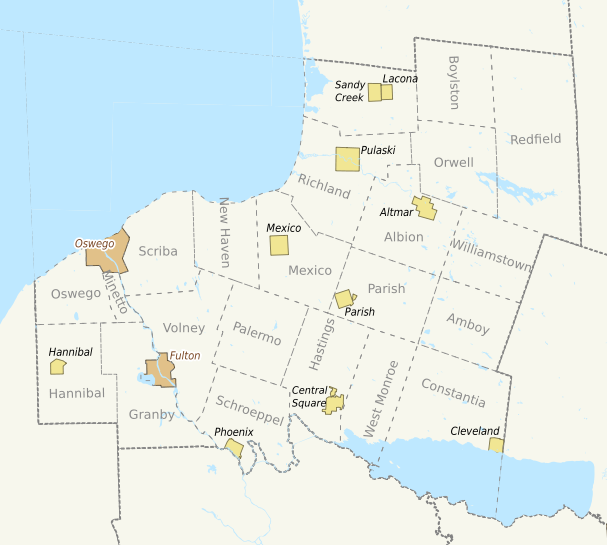Oswego County Functions
County Government
While originally established to serve as instrumentalities of the state existing for state purposes, counties in New York are now full service general purpose units of government that provide a vast array of services to their residents.
What is a County?
New York counties began as entities established by the State Legislature to carry out specified functions at the local level on behalf of the state. During
the 20th century, county government in New York underwent major changes in function, form and basic nature.
The counties in New York are no longer merely subdivisions of the state that primarily exist to perform state functions. The county is now a municipal
corporation with geographical jurisdiction, home rule powers and the fiscal capacity to provide a wide range of services to its residents. To some extent,
counties have evolved into a form of "regional" government that performs specified functions and which encompasses, but does not necessarily supersede, the
jurisdiction of the cities, towns and villages within its borders.
New York State outside New York City is divided into 57 counties. The five boroughs of the City of New York function as counties for certain purposes,
although they are not organized as such nor do they operate as county governments. Unless otherwise indicated, references to counties in this chapter will
apply only to those outside New York City.
Counties in New York are very diverse in population and demographics. The 2000 Census populations of the counties vary from Suffolk County's 1, 419, 369 to
Hamilton County's 5, 379. St. Lawrence County is the largest in geographical area, with over 2, 700 square miles, and Rockland is the smallest, with 175
square miles. The most densely populated county is Nassau County with more than 4, 500 people per square mile, and the most sparsely populated is Hamilton
County, with fewer than 3 people per square mile. The population of New York's counties is shown in Table 6.
Of the state's 57 counties outside New York City, 21 contain no cities. All counties include towns and villages,although the number of each varies widely,
from 32 towns in St. Lawrence, Cattaraugus and Steuben counties to three towns in Nassau County, and from Hamilton and Warren counties' one village each to
Nassau County's 64 villages.
The foregoing statistics indicate that it can be deceptive to speak of counties in New York State as though they were all alike. New York counties are
among the most urban and the most rural in the nation, and the interests, concerns and governmental expectations of their residents are similarly diverse.
Historical Development
The patterns of county government organization in New York were set in colonial times. The "Duke's Laws" of 1665 created "ridings," or judicial districts,
which were in effect a system of embryonic counties. In 1683, an act of the first Assembly of the Colony established the first 12 counties - adding 2 to
the 10 which had previously come into existence - and created the office of sheriff in each county. These original counties were Albany, Cornwall, Dukes,
Duchess, Kings, New York, Orange, Queens, Richmond, Suffolk, Ulster, and Westchester. Cornwall and Dukes were deemed part of Massachusetts after 1691.
County legislative bodies began at the same time, when freeholders, later known as supervisors, were elected to represent each town in the establishment of
tax rates to defray the costs of county government, including the operation of a court house and a jail.
The reasons for the creation of county governments in the early colonial period appear to have been practical: to improve protection against enemies and to
provide a more broadly based mechanism for maintaining law and order. The first duties of county government lay in these functional areas. It is of
interest to note that the sheriffs in the first counties were appointed by the Governor and could serve only one term.
The first State Constitution in 1777, which designated counties, towns and cities as the only units of local government, recognized the existence of 14
counties that had been established earlier by the colonial Assembly. Two of those counties were ceded to Vermont in 1790 in the settlement of the New
Hampshire land-grant controversy. All of New York's other 50 counties were created by acts of the State Legislature. The state's newest county, Bronx, was
established in 1914.
The basic composition of the counties was set in 1788 when the State Legislature divided all of the existing counties into towns. Towns, of course, were of
earlier origin, but in that year they acquired a new legal status as components of the counties.
Throughout the nineteenth century, additional counties were created, usually when an area contained approximately 1,000 residents. New counties were
typically formed out of existing counties, some of which originally covered vast geographical areas.
TABLE 6
New York State Counties
|
COUNTY |
Administrative Official |
Legislative Body |
Number of Members |
Population** |
|
Albany* |
Executive |
Legislature |
39 |
294,565 |
|
Allegany |
Administrator |
Legislature |
15 |
49,927 |
|
Broome* |
Executive |
Legislature |
19 |
200,536 |
|
Cattaraugus |
Administrator |
Legislature |
21 |
83,955 |
|
Cayuga |
Chair of Legislative Body |
Legislature |
15 |
81,963 |
|
Chautauqua* |
Executive |
Legislature |
25 |
139,750 |
|
Chemung* |
Executive |
Legislature |
15 |
91,070 |
|
Chenango |
Chair of Legislative Body |
Supervisors |
23 |
51,401 |
|
Clinton |
Administrator |
Legislature |
10 |
79,894 |
|
Columbia |
Chair of Legislative Body |
Supervisors |
22 |
63,094 |
|
Cortland |
Chair of Legislative Body |
Legislature |
19 |
48,599 |
|
Delaware |
Chairof Legislative Body |
Supervisors |
19 |
48,055 |
|
Dutchess* |
Executive |
Legislature |
25 |
280,150 |
|
Erie* |
Executive |
Legislature |
17 |
950,265 |
|
Essex |
Manager |
Supervisors |
18 |
38,851 |
|
Franklin |
Manager |
Legislature |
7 |
51,134 |
|
Fulton |
Chair of Legislative Body |
Supervisors |
20 |
55,073 |
|
Genesee |
Manager |
Legislature |
9 |
60,370 |
|
Greene |
Administrator |
Legislature |
14 |
48,195 |
|
Hamilton |
Chair of Legislative Body |
Supervisors |
9 |
5,379 |
|
Herkimer* |
Administrator |
Legislature |
17 |
64,427 |
|
Jefferson |
Administrator |
Legislature |
15 |
111,738 |
|
Lewis |
Manager |
Legislature |
10 |
26,944 |
|
Livingston |
Administrator |
Supervisors |
17 |
64,328 |
|
Madison |
Chair of Legislative Body |
Supervisors |
19 |
69,441 |
|
Monroe* |
Executive |
Legislature |
29 |
735,343 |
|
Montgomery |
Administrator |
Supervisors |
15 |
49,708 |
|
Nassau* |
Executive |
Legislature |
19 |
1,334,544 |
|
Niagara |
Chair of Legislative Body |
Legislature |
19 |
219,846 |
|
Oneida* |
Executive |
Legislature |
29 |
235,469 |
|
Onondaga* |
Executive |
Legislature |
19 |
458,336 |
|
Ontario |
Administrator |
Supervisors |
21 |
100,224 |
|
Orange* |
Executive |
Legislature |
21 |
341,367 |
|
Orleans |
Administrator |
Legislature |
7 |
44,171 |
|
Oswego |
Administrator |
Legislature |
25 |
122,377 |
|
Otsego |
Chair of Legislative Body |
Legislature |
14 |
61,676 |
|
Putnam* |
Executive |
Legislature |
9 |
95,745 |
|
Rensselaer* |
Executive |
Legislature |
19 |
152,538 |
|
Rockland* |
Executive |
Legislature |
17 |
286,753 |
|
St.Lawrence |
Administrator |
Legislature |
15 |
111,931 |
|
Saratoga |
Administrator |
Supervisors |
23 |
200,635 |
|
Schenectady* |
Manager |
Legislature |
15 |
146,555 |
|
Schoharie |
Chair of Legislative Body |
Supervisors |
16 |
31,582 |
|
Schuyler |
Chair of Legislative Body |
Legislature |
8 |
19,224 |
|
Seneca |
Manager |
Supervisors |
14 |
33,342 |
|
Steuben |
Administrator |
Legislature |
17 |
98,762 |
|
Suffolk* |
Executive |
Legislature |
18 |
1,419,369 |
|
Sullivan |
Manager |
Legislature |
9 |
73,966 |
|
Tioga |
Chair of Legislative Body |
Legislature |
9 |
51,784 |
|
Tompkins* |
Administrator |
Legislature |
15 |
96,501 |
|
Ulster |
Administrator |
Legislature |
33 |
177,749 |
|
Warren |
Administrator |
Supervisors |
20 |
63,303 |
|
Washington |
Administrator |
Supervisors |
17 |
61,042 |
|
Wayne |
Administrator |
Supervisors |
15 |
93,765 |
|
Westchester* |
Executive |
Legislature |
17 |
923,459 |
|
Wyoming |
Administrator |
Supervisors |
16 |
43,424 |
|
Yates |
Administrator |
Legislature |
14 |
24,621 |
* Charter County
** 2000 Census.
SOURCE: U.S. Bureau of the Census, courtesy of Empire State Development Corporation.
County government information courtesy New York State Association of Counties.
New York City Boroughs/Counties
|
Borough |
Population** |
|
Bronx |
1,332,650 |
|
Kings |
2,465,326 |
|
NewYork |
1,537,195 |
|
Queens |
2,229,379 |
|
Richmond |
443,728 |
** 2000 Census.
SOURCE: U.S. Bureau of the Census, courtesy of Empire State Development Corporation.
The Changing Nature of County Government
The basic changes in form, powers and functions, which the counties in New York have been undergoing, have been hastened and facilitated by three major developments:
• The rapid urbanization of many areas of the state after World War II, particularly in the environs of large cities; • The availability, by general law, of authority for the residents of a county to draft and adopt a home rule charter to provide whatever form of government they consider most appropriate to local needs, and through the charter, to assign to the county government duties and functions they want the county to undertake - within state Constitutional and statutory limitations; • Basic alteration of the representative base for county legislative bodies resulting from federal and state court rulings requiring that such representation comply with the "one person-one vote" principle. While county government still must perform as an administrative arm of state government for many purposes, at the same time it must be an independent unit of government exercising powers of its own to meet new, difficult and complex demands. As the population spilled out from the central cities of the metropolitan areas, the towns and the counties occupying the periphery had to take on a wide range of new functions, services and duties. As a result, the forms and procedures of county government changed to meet the needs of the metropolitan areas. At the same time, however, the old forms of county government, which largely reflected rural needs and county functions as state administrative units, were retained in areas where they were still appropriate. Even in the latter case, however, it has proven convenient for the state to use the counties in new ways for new purposes in carrying out new state programs and objectives. At the present time, most New Yorkers live in counties that are now considered urban because of their population or proximity to a major city. Some counties are marginally urban because of their economic orientation and because people journey to work from those counties to larger metropolitan centers that may be some distance away. This very fact, however, lends an urban aura to those counties even though their primary activities may still have rural characteristics.The County Charter Movement
One of the developments that has facilitated the changing nature of county government in New York has been the provision of general law authority for
counties to draft and adopt home rule charters by local initiative and action.
Most of the counties of the state still operate, as they did in the past, under the general provisions of the New York State County Law. Even these
counties have certain latitude under state law to develop their own organizational structures and to provide for the administration of their services. In
fact, a majority of the counties that operate under the County Law have a county administrator or comparable position.
Any county, regardless of size, may gain a much wider scope for local initiative and action through the adoption of a county charter. Table 7 lists the 19
charter counties in New York and the year of adoption of their current charter.
TABLE 7
Charter Counties In New York
|
County |
Date Charter Adopted |
|
Nassau |
1936 |
|
Westchester |
1937 |
|
Suffolk |
1958 |
|
Erie |
1959 |
|
Oneida |
1961 |
|
Onondaga |
1961 |
|
Monroe |
1965 |
|
Schenectady |
1965 |
|
Broome |
1966 |
|
Herkimer |
1966 |
|
Dutchess |
1967 |
|
Orange |
1968 |
|
Tompkins |
1968 |
|
Rensselaer |
1972 |
|
Albany |
1973 |
|
Chemung |
1973 |
|
Chautauqua |
1974 |
|
Putnam |
1977 |
|
Rockland |
1983 |
The spread of the county charter movement in New York has been a relatively recent phenomenon. In 1937, the Legislature enacted an Optional County
Government Law which broadened the scope of local choice as to organization and form. By the early 1950's only three counties - Nassau, Monroe and
Westchester - had organized under optional or special charters granted by the State Legislature. Because of the counties indifferent response to this form,
in 1952 the Legislature repealed the optional County Government Law and enacted the Alternative County Government Law, which extended to the counties a
choice of four optional alternative forms of government organization. However, no county utilized the provisions of this law. In 1958, Suffolk County was
granted an alternative form of county government by special state legislation.
An amendment to the State Constitution in 1959 provided the necessary constitutional basis for locally developed and adopted charters. With the
implementing statutes enacted by the State Legislature, the amendment enabled counties to adopt charters that could supersede the governmental structures
provided in the County Law. The response was immediate; Erie County in 1959 was the first to adopt its own charter under the new law. In 1961, Oneida and
Onondaga Counties followed. Enactment in 1963 of the Municipal Home Rule Law, to which the County Charter Law provisions were transferred, further
facilitated the reorganization by charter of county governments. Since that change, the number of counties operating under charters has increased to 19.
One of these counties - Herkimer - chose only to reapportion the county legislative body through the county charter method and left intact the
organizational arrangements provided under the County Law.
Reform of County Legislative Bodies
A third recent development that significantly impacted county government in New York was the reapportionment of representation in county legislative bodies
in response to judicial mandates.
From the earliest days of county government, the county's legislative body - and its executive and administrative elements as well - was a board of
supervisors. The board of supervisors consisted primarily of the supervisors of the towns within the county who were elected solely as town officers at
town elections but who served ex officio as county legislators. In counties containing cities a number of "city supervisors" were elected by city voters,
usually by wards, to serve solely as county officials and having no other duties as city officials.
In the early 1960's, the courts found that many of the arrangements in New York for boards of supervisors violated the Equal Protection clause of the
Fourteenth Amendment of the United States Constitution. The basis for this ruling was the fact that each town in a county, small or large, had one vote in
the legislative body. Thus, a voter in a town with a population of a hundred wielded ten times more weight in the county legislative body than did a voter
in a town of a thousand. Accordingly, the counties were ordered to bring the apportionment of their legislative bodies into compliance with the principle
of one person-one vote.
The counties of New York State have used one of two basic methods to comply with the Supreme Court's mandate: weighted voting or districting. Some counties
still retain the board of supervisor's arrangement, but with an appropriate weighting of the relative voting strength of each supervisor. Other counties
now elect legislators from districts, which may or may not coincide with town lines.
Variations of these two basic methods have been used to accommodate local conditions. In some counties, weighted voting provides that each legislator
"casts the decisive vote on legislation in the same ratio which the population of his or her constituency bears to the total population." In others, the
weighting simply reflects the represented population. Districting has taken the form of single or multi-member districts or a mix of both.
In many cases, the members of the county legislative bodies now occupy their positions in that capacity alone; they are clearly county legislators, elected
as such. This is a major change in the basic structure of county government, since it can be argued that until the county had its own independently elected
legislative body, it could not truly be regarded as a full unit of local government with its own defined powers and its own authority to utilize those
powers in response to countywide needs.
County Government Orginization
Four organizational elements exist in some form and in varying degrees among all counties, both charter and noncharter. These are: (1) a form of executive or administrative authority, either separate from or as a part of legislative authority; (2) a legislative body; (3) an administrative structure; and (4) certain elective or appointed officers who carry out specific optional duties and functions.
Executive and Administrative Authority
Non-charter Counties.
The County Law, which provides the legal framework for non-charter county government, makes no provision for an independent executive or administrative authority. The executive and legislative authority remain joined in the legislative body, which may exercise that function indifferent ways. The legislative body may organize its committee structure around the functional areas of county government; each committee or its chairman exercises a certain amount of supervisory or administrative authority on behalf of the legislative body over the operational arrangements for the provision of the specific service or activity. The legislature may also delegate to its chairman a substantial amount of administrative authority to be exercised on its behalf.As long as the functions of county government were relatively few and simple, such arrangements assured the legislature of direct information about day-to-day county operations. As county functions and programs increased in number, diversified in kind, and expanded enormously in both complexity and cost, this fragmentation of administrative authority often fell short of providing necessary overall supervision and coordinated direction. Partly to correct this inadequacy, the county charter movement spread rapidly during the 1950's and 1960's among the larger and rapidly urbanizing counties of the state.
In addition to the internal arrangements whereby a county legislative body may exercise a certain amount of executive and administrative authority, several provisions of law authorize the county legislature to establish the office of county administrator or a similar office to carry out, on behalf of the legislature, certain administrative functions.
The first of these provisions is section 10(1)(a)(1) of the Municipal Home Rule Law, which authorizes local governments to enact local laws relating to the powers, duties, qualifications, number, mode of selection and removal, and terms of office of their officers and employees. Under this provision, a county may create the office of county administrator or manager, and assign to the office certain administrative functions and duties to be performed on behalf of the county legislature.
A county legislature should keep two factors in mind when creating such an office. The first is to determine whether the powers and functions to be assigned to the office would either diminish the powers of any elected county official or transfer to such an office any powers and duties presently vested by law in other county offices. In such situations, the Municipal Home Rule Law provides for a mandatory referendum. The second is to determine how far the county legislature is empowered to go in assigning various functions and duties to the office of county administrator. At what point will the legislature, in effect, be enacting an alternative form of county government? In other words, how far can the county go in assigning powers and functions before it becomes necessary to enact a county charter?
Another option is found in the Municipal Home Rule Law, section 10(1)(b)(4), which authorizes a county to create by local law the position of administrative assistant to the chairman of the board of supervisors. While such a law may assign specified administrative functions, powers, or duties to this office, the board must remain the final authority with respect to such administrative functions and duties.
Finally, section 204 of the County Law provides that the county legislative body may establish the position of "executive assistant" by local law, resolution, or by inclusion in the county budget.
The foregoing illustrates that a county government without a charter still has a number of options through which it can provide itself with a certain amount of administrative leadership and day-to-day direction. However, the legislative body must retain the executive authority generally embodied in making policy and developing the annual budget.
Charter Counties.
The principal difference between a county government operating pursuant to the County Law and one operating pursuant to a charter is that a county charter ordinarily provides for an executive or administrator, independent of the legislature, who administers the day-to-day affairs of county government. Of the 19 charter counties in the state, 16 have elected executives, while 2 have professional managers.Voters in the charter counties of New York, in most cases, have chosen the elected executive form of county government organization. The creation of the office of elected executive provides the county with potentially strong leadership, because the executive is elected by the voters of the entire county. Thus, the executive operates from a strong political base to speak for the county, and to exercise leadership in relation to the legislative body. This principle holds true even where the charter does not endow the executive with extensive powers.
The elected executive also provides a focus of public attention in county government that is lacking in the organization under the County Law. Like elected executives at other levels, the county executive operates under constant scrutiny.
Under most county charters, the elected county executive may secure additional professional administrative assistance, subject to appropriated funds. For example, the executive may provide, within the annual appropriation, for the creation of the office of deputy county executive for administration or for an executive assistant to carry out responsibilities that may be delegated by the executive.
One of the most influential elements of the elected executive's authority is the budgetary power, an essential tool of executive participation in policy development and in strong administration. Through the framing of an executive budget, the county executive establishes and recommends to the county legislature priorities among programs. If they are approved by the legislative body, these priorities provide a direction for the implementation of policies.
Another important element of the authority of the county executive or county manager in charter counties is the power to appoint and remove department heads. The charter may allow the executive to exercise this authority without confirmation or approval by the legislative body, and in other cases, the charter may require the confirmation or approval of the action. In either case, the executive must exercise this authority within the scope of the applicable civil service laws as described in Chapter XIII.
Initially, the size of a county's population has much to do with whether the county's voters believe it is necessary to provide the county with executive leadership and day-to-day direction of operations by adopting a locally drafted charter. It is possible, however, that other considerations, such as fiscal concerns, are of equal importance. Without a strengthening of executive capacity, the urbanizing counties of the state found themselves severely handicapped in meeting and dealing with new and expanding service demands. Legal authority to draft and adopt a charter locally, one specifically tailored to fit local conditions and requirements, has facilitated the efforts of counties to meet their rapidly growing responsibilities as true units of local government.
County Legislative Bodies
Every county has power to enact laws, adopt resolutions, and take other actions having the force of law within its jurisdiction. This power, along with the
related authority to make policy determinations, is vested in a legislative body.
The legislative bodies of the counties are designated by various names, including Board of Supervisors, Board of Representatives, Board of Legislators, and
County Legislature. Originally, the legislative bodies of all counties were boards of supervisors, consisting of the town and city supervisors. With the
adoption of various reapportionment plans and with the spread of home rule charters however, other designations were developed according to local
preference.
Figure 6 shows the basic makeup of county legislative bodies, along with their 2000 Census populations. This figure illustrates that neither the size of a
county's population nor the fact of having a charter have little if anything to do with the size of a county's legislative body. Legislatures range in size
from seven members in Franklin and Orleans Counties to 39 in Albany County.
Generally, members of county legislative bodies are elected for either two or four year terms. In counties that have retained a Board of Supervisors, the
term of office for each member is two years, except in towns that have exercised the option under the Town Law to extend the term to four years. Of the 57
county legislative bodies, 36 conduct scheduled meetings once a month and 17 meet twice a month. Other meeting patterns are practiced by three counties,
and one legislative body, Herkimer, conducts a scheduled meeting quarterly, but holds additional meetings as needed. All of the legislative bodies convene
for special meetings, a fairly frequent occurrence in many counties.
Since the role of the county as a true unit of local government continues to evolve, the legislative bodies of New York counties are also continuing to
change. Their committee structures, rules of procedure, and patterns of action may reflect some practices of earlier times, but it is clear that
adjustments are under way. The heightened responsibility of members of county legislative bodies is indicated by the fact that the budgets they must
consider and adopt each year range from tens of millions of dollars in small counties to hundreds of millions in large counties. Several counties have
budgets in excess of one billion dollars, and Nassau County's budget nears three billion dollars.24
Administrative Structure
The administrative structures of county governments in New York are generally similar. The basic organizational arrangements and operational procedures of county administration were set at a time when the functions and duties were few, relatively simple and largely reflective of state objectives. In some counties with smaller and homogeneous populations, the traditional arrangements still provide an adequate administrative structure.
FIGURE 6
County GovernmentCounty Law Form Organization Chart
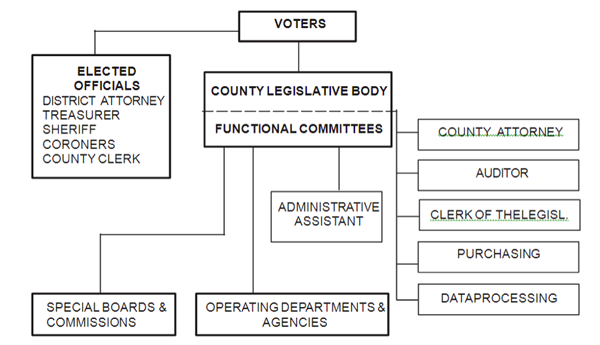
In the large counties, however, urbanization has created a need for new patterns of administration as well as new leadership arrangements. The result has
been a rapid growth in both the size and complexity of county administrative structures. These arrangements meet the needs of both ongoing traditional
county functions, such as law enforcement and record keeping, as well as the newer county functions in such areas as industrial and economic development,
mental health services, and the provision of recreational facilities and programs.
The administrative structures of New York counties generally fall into three categories: (1) organization under the County Law; (2) organization with an
elected county executive; and (3) organization with an appointed manager or administrator. As might be expected, there are many similarities among these
three forms, but there are also differences. As illustrated in Figures 6, 7, and 8, the primary differences among the three forms are at the top, in the
relationship between the elected representative body and how the county is functionally administered. The administrative structure of a county government
does not depend on whether the county elects an executive, appoints a manager, or leaves administrative direction and supervision to its legislative body.
However, most of the larger counties have found it desirable, if not necessary, to divide their administrative structures into many departments. This
organizational structure facilitates proper direction and supervision of what have become large-scale enterprises.
FIGURE 7
County GovernmentExecutive Form Organization Chart
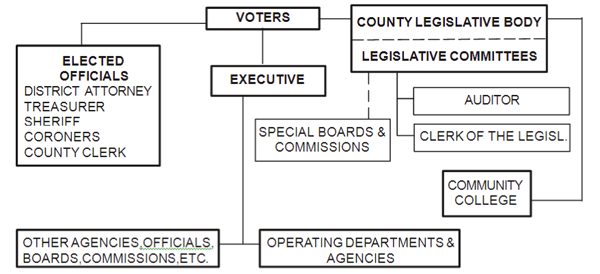
FIGURE 8
County GovernmentManager Form Organization Chart
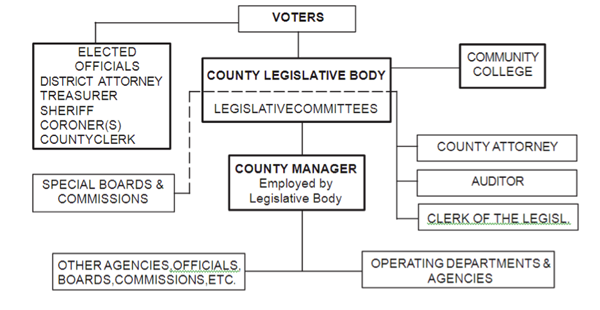
Other Elected and Appointed Officers
In counties organized under the County Law, the following officials must be elected: district attorney, sheriff, coroner(s)25 and county clerk. Under a
home rule charter, a county may alter some of these officers'duties, subject to referendum. The treasurer must also be elected, but this office may be
eliminated under either the County Law or a home rule charter.
Many of the charter counties have dropped the office of treasurer and incorporated its functions with those of a director of finance. The office of
sheriff, although based in the Constitution, may also be substantially modified. In counties with county police departments, for example, the office of
sheriff has few, if any, law enforcement functions, but may retain civil functions and responsibility for operating a county correctional facility.
The Functions of County Government
At the beginning of this chapter we noted that the principal reasons for creating county governments in the colonial period were to facilitate the defense
of the community against enemies and to maintain public order.
With the establishment of state government, the counties provided an already existing and readily available administrative unit through which the state
could carry out a number of its functions and duties. To do this, the counties found themselves keeping records on behalf of the state, enforcing state
laws and conducting elections for the state, among other state-assigned functions. In New York, as in other states, the prevailing view saw county
government as an arm of state government, serving state purposes.
It is doubtful that many residents of the counties of New York ever fully shared this assessment of the nature of the county. The people of the counties
appear to have felt from earliest times that the county, like the city, the town and the village, was one of "their" local governments, even though it may
have performed duties for the state.
The recent fundamental changes in the nature and form of county government in New York have in some ways brought the legal concept of a county closer in
line with the concept held by most of the counties' inhabitants. The impetus for this merger of the de jure with the de facto probably sprang from the
rapidly expanding demands for services, which were stimulated by population growth and urbanization, which often could not be supplied by the towns,
cities, and villages.
The functions of county government at the beginning of the twenty-first century scarcely resemble those of colonial times, although the county still
enforces laws and maintains order. In 1980, the total expenditures by county government in New York amounted to $5.5 billion. By
2003, this amount had grown to over $16.4 billion. To see what counties are doing today and to illustrate the demands now being placed on county
government, it is useful to examine how county government spends it money. Table 8 shows the dollar amount and percent distribution of major expenditures
for all counties for 1980 and 2003.
TABLE8
Trends in County Expenditures by Purpose|
Expenditure
|
1980Amount |
Distribution |
2003Amount |
Distribution |
|
|
(millionsofdollars) |
(percent) |
(millionsofdollars) |
(percent) |
||
|
General |
504 |
9.2 |
2,005 |
12.2 |
|
|
Police and |
515 |
9.4 |
2,924 |
17.8 |
|
|
Health |
644 |
11.8 |
2,188 |
13.3 |
|
|
Transportation |
430 |
7.9 |
1,194 |
7.3 |
|
|
Economic |
2,589 |
47.4 |
5,852 |
35.6 |
|
|
Culture and |
131 |
2.4 |
349 |
2.1 |
|
|
Education |
144 |
2.6 |
868 |
5.2 |
|
|
Home and |
500 |
9.2 |
1,050 |
6.4 |
|
|
Total |
5,458 |
100.0 |
16,430 |
100.0 |
|
|
|
|
|
|
|
|
SOURCE: Office of the New York State Comptroller.
Economic assistance, which includes social services programs such as Medicaid and Aid to Dependent Children, remains the largest category of expenditure
for county government. However, the share of the distribution of expenditure for this category has declined as expenditures in other categories have
increased and accounting for Medicaid expenditures has changed. In 1980, county expenditures for Medicaid reflected the entire cost of the program
(counties paid the full cost and were then reimbursed from state and federal sources). In 2003, how- ever, county medical expenditures reflect only the
county contribution (roughly 25 per cent of total Medicaid costs), making comparisons between these years difficult. The greatest percentage of growth in
dollar terms has been in the education category, which includes the counties' obligation to pay for the education of pre-school special education children
as well as the costs of providing com- munity college education to county residents. Police and public safety has also experienced significant growth and
expenditures accounting for the cost of operating a jail in addition to the expenses of a sheriff's department, plus probation and rehabilitation services.
General government includes staffing and administrative costs of county officials, the district attorney, public defenders, maintenance of buildings and
other central operations.
Transfer of Functions
Article 9, section 1(h)(l) of the State Constitution authorizes alternative forms of county government26 to transfer functions or duties from one unit of local government to another, subject to referenda approval. Any such transfer, whether included in a proposed county charter or charter amendment, or by local law through procedures set forth in section 33-a of the Municipal Home Rule Law, must be approved by separate majorities in the area of the county outside the cities, and in all cities in the county, if any, "considered as one unit." In addition, if a function or duty is transferred to or from any village, the transfer must also be approved by a majority of voters in all villages so affected, again "considered as one unit."
In many cases, counties have assumed new activities without formal transfer of the function. So long as the county has power to engage in a specific activity —the provision of parks, for example - it often does so at the same time that cities, towns and villages undertake similar activity. This power of the local units to carry out the same activity presents local taxpayers with recurring policy questions regarding which units can perform each service best and at least cost. In many cases cities have urged counties to assume activities, such as oversight of parks, zoos, civic centers and the like, not only to spread the cost more equitably, since all county residents are likely to use such facilities, but also because the county has greater ability to finance such activities.
Summary
Although the counties still carry out, in one way or another, their original functions and duties, they also have taken on a vast array of new ones. As a result, county governments in New York have had to adapt so that they can provide and finance these services for all the cities, towns and villages within their jurisdiction.
County government has been strengthened as a unit between the cities, towns and villages on the one hand and the state government on the other. The State Legislature and the people of the state have made it possible, through the Constitution and statutes, for the counties to restructure themselves, if they choose, to provide the executive and administrative leadership, the administrative organization and the operational procedures required meeting new demands.
In urban areas, the counties are now major providers of services, and it appears likely that county government will continue to assume new responsibilities.
Information courtesy of the Department of State

